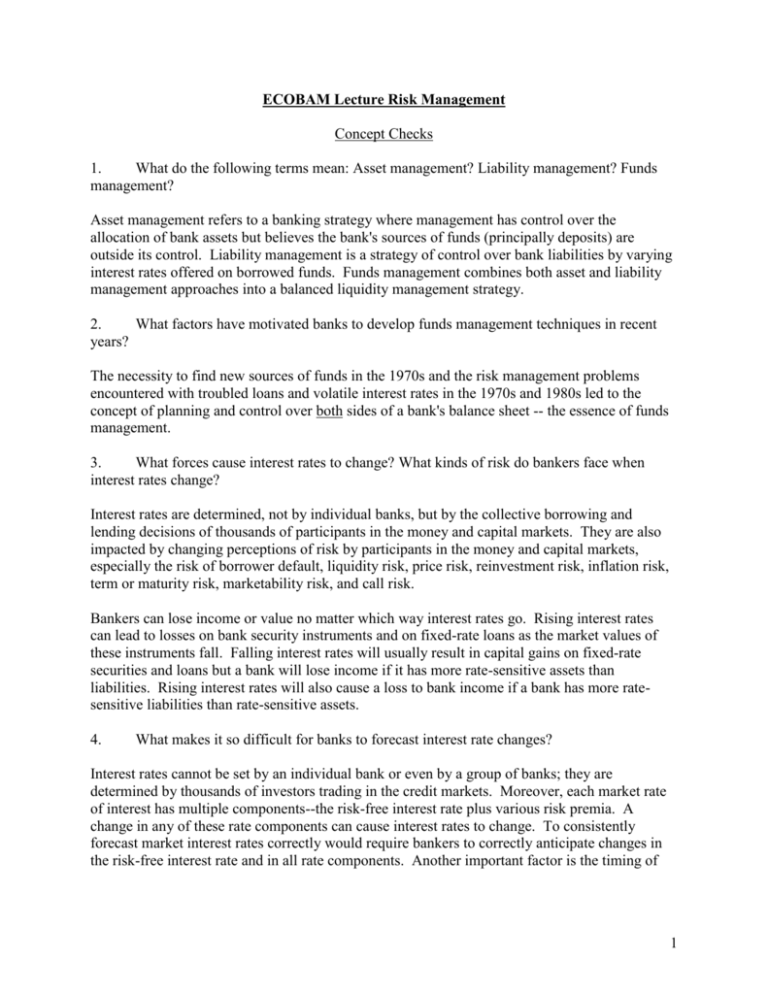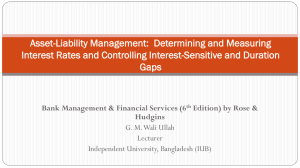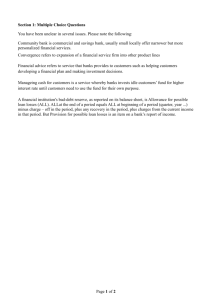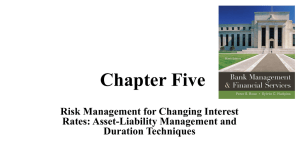Interest-Sensitive Liabilities
advertisement

ECOBAM Lecture Risk Management Concept Checks 1. What do the following terms mean: Asset management? Liability management? Funds management? Asset management refers to a banking strategy where management has control over the allocation of bank assets but believes the bank's sources of funds (principally deposits) are outside its control. Liability management is a strategy of control over bank liabilities by varying interest rates offered on borrowed funds. Funds management combines both asset and liability management approaches into a balanced liquidity management strategy. 2. What factors have motivated banks to develop funds management techniques in recent years? The necessity to find new sources of funds in the 1970s and the risk management problems encountered with troubled loans and volatile interest rates in the 1970s and 1980s led to the concept of planning and control over both sides of a bank's balance sheet -- the essence of funds management. 3. What forces cause interest rates to change? What kinds of risk do bankers face when interest rates change? Interest rates are determined, not by individual banks, but by the collective borrowing and lending decisions of thousands of participants in the money and capital markets. They are also impacted by changing perceptions of risk by participants in the money and capital markets, especially the risk of borrower default, liquidity risk, price risk, reinvestment risk, inflation risk, term or maturity risk, marketability risk, and call risk. Bankers can lose income or value no matter which way interest rates go. Rising interest rates can lead to losses on bank security instruments and on fixed-rate loans as the market values of these instruments fall. Falling interest rates will usually result in capital gains on fixed-rate securities and loans but a bank will lose income if it has more rate-sensitive assets than liabilities. Rising interest rates will also cause a loss to bank income if a bank has more ratesensitive liabilities than rate-sensitive assets. 4. What makes it so difficult for banks to forecast interest rate changes? Interest rates cannot be set by an individual bank or even by a group of banks; they are determined by thousands of investors trading in the credit markets. Moreover, each market rate of interest has multiple components--the risk-free interest rate plus various risk premia. A change in any of these rate components can cause interest rates to change. To consistently forecast market interest rates correctly would require bankers to correctly anticipate changes in the risk-free interest rate and in all rate components. Another important factor is the timing of 1 the changes. To be able to take full advantage of their predictions, they also need to know when the changes will take place. 5. What is the yield curve and why is it important for bankers to know about its shape or slope? The yield curve is a graphical description of the distribution of market interest rates by maturity of financial instrument. The slope of the yield curve determines the spread between long-term and short-term interest rates. In banking most of the long-term rates apply to loans and securities (i.e., bank assets) and most of the short-term interest rates are attached to bank deposits and money market borrowings. Thus, the shape or slope of the yield curve has a profound influence on a bank's net interest margin or spread between asset revenues and liability costs. 6. What is it that a bank wishes to protect from adverse movements in interest rates? A bank wishes to protect both the value of bank assets and liabilities and the revenues and costs generated by both assets and liabilities from adverse movements in interest rates. 7. What is the goal of hedging in banking? The goal of hedging in banking is to freeze the spread between asset returns and liability costs and to offset declining values on certain assets by profitable transactions so that a target rate of return is assured. 6-8. First National Bank of Bannerville has posted the following financial statement entries: Interest revenues $63 million Interest costs $42 million Total earning assets $700 million The bank's net interest margin must be: Net Interest Margin = $63 mill. - $42 mill. = 0.03 or 3 percent $700 mill. If interest revenues and interest costs double while earning assets grow by 50 percent, the net interest margin will change as follows: ($63 mill. - $42 mill.) * 2 $700 mill. * (1.50) = 0.04 or 4 percent Clearly the net interest margin increases--in this case by one third. 9. Can you explain the concept of gap management? Gap management involves determining the maturity distribution and the repricing schedule for a bank's assets and liabilities. When more assets are subject to repricing or will reach maturity in a 2 given period than liabilities or vice versa, the bank has a GAP and is exposed to loss from adverse interest-rate movements based on the gap's size. 10 When is a bank asset sensitive? Liability sensitive? A bank is asset sensitive when it has more interest-rate sensitive assets maturing or subject to repricing during a specific time period than rate-sensitive liabilities. A liability sensitive position, in contrast, would find the bank having more interest-rate sensitive deposits and other liabilities than rate-sensitive assets for a particular planning period. 11. Commerce National Bank reports interest-sensitive assets of $870 million and interestsensitive liabilities of $625 million. Because interest-sensitive assets are larger than liabilities by $245 million the bank is asset sensitive. If interest rates rise, the bank's net interest margin should rise as asset revenues increase by more than the resulting increase in liability costs. On the other hand, if interest rates fall, the bank's net interest margin will fall as asset revenues decline faster than liability costs. 12. First National Bank has a cumulative gap for the coming year of + $135 million and interest rates are expected to fall by two and a half percentage points. What is the expected change in First National's net interest income? Expected Change in Net Interest Income = $135 million * (-0.025) = -$3.38 million What change will occur in net interest income if interest rates rise by one and a quarter percentage points? Expected Change in Net Interest Income = $135 million * (+0.0125) = +$1.69 million 13 How do you measure a bank’s dollar interest-sensitive gap? Its relative interest-sensitive gap? What is the interest-sensitivity ratio? The dollar interest-sensitive gap is measured by taking the repriceable (interest-sensitive) assets minus the repriceable (interest-sensitive) liabilitiies over some set planning period. Common planning periods include 3 months, 6 months and 1 year. The relative interest-sensitive gap is the dollar interest-sensitive gap divided by some measure of bank size (often total assets). The interest-sensitivity ratio is just the ratio of interest-sensitive assets to interest sensitive liabilities. Regardless of which measure you use, the results should be consistent. If you find a positive (negative) gap for dollar interest-sensitive gap, you should also find a positive (negative) relative interest-sensitive gap and a interest sensitivity ratio greater (less) than one. 3 14 Suppose Carroll Bank and Trust reports interest-sensitive assets of $570 million and interest-sensitive liabilities of $685 million. What is the bank’s dollar interest-sensitive gap? Its relative interest-sensitive gap and interest-sensitivity ratio? Dollar Interest-Sensitive Gap = Interest-Sensitive Assets – Interest Sensitive Liabilities = $570 - $685 = -$115 Relative Gap = Interest-Sensitivity Ratio $ IS Gap Bank Size = = -$115 $570 = -0.2018 or -20.18 percent Interest-Sensitive Assets Interest-Sensitive Liabilities = $570 $685 = .8321 15 Explain the concept of weighted interest-sensitive gap. How can this concept aid bank’s real interest-sensitive gap risk exposure? Weighted interest-sensitive gap is based on the idea that not all interest rates change at the same speed. Some are more sensitive than others. Interest rates on bank assets may change more slowly than interest rates on liabilities and both of these may change at a different speed than those interest rates determined in the open market. In, the weighted interest-sensitive gap methodology all interest-sensitive assets and liabilities are given a weight based on their speed (sensitivity) relative to some market interest rate. Fed Funds loans, for example, have an interest rate which is determined in the market and which would have a weight of 1. All other loans, investments and deposits would have a weight based on their speed relative to the Fed Funds rate. To determine the interest-sensitive gap, the dollar amount of each type of asset or liability would be multiplied by its weight and added to the rest of the interest-sensitive assets or liabilities. Once the weighted total of the assets and liabilities is determined, a weighted interestsensitive gap can be determined by subtracting the interest-sensitive liabilities from the interestsensitive assets. This weighted interest-sensitive gap should be more accurate than the unweighted interest-sensitive gap. The interest-sensitive gap may change from negative to positive or vice versa and may change significantly the interest rate strategy pursued by the bank. Problems 1. A government bond is currently selling for $900 and pays $80 per year in interest for 5 years when it matures. If the redemption value of this bond is $1,000, what is its yield to maturity if purchased today for $900. The yield to maturity equation for this bond would be: $900 = $80 (1 YTM) 1 + $80 (1 YTM) 2 + $80 (1 YTM) 3 + $80 (1 YTM) 4 + $80 (1 YTM) 5 + $1,000 (1 YTM)5 At an YTM of 10 percent the bond's price is $924.28, while at 12 percent its price becomes $864.40. Thus, the true YTM lies between 10% and 12%. To find the true YTM we use: 4 10% + $924.28 $900 * 2% 10.81% $924.28 $864.40 2. Suppose the government bond described in problem #1 is held for 3 years and then the bank acquiring the bond decides to sell it at a price of $950. Can you figure out the average annual yield the bank will have earned for its 3-year investment in the bond? In this instance the yield-to-maturity equation can be modified slightly to find the correct holding-period yield that the bank would earn. Specifically, $900 = $80 (1 HPY)1 + $80 (1 HPY)2 + $80 (1 HPY)3 + $950 (1 HPY)3 At an HPY of 10% the bond's price becomes $912.31, while at 12% the bond's price is $868.56. The true holding period yield must be: 912.31 900 10% + x 2% 10.56%. 912.31 868.56 3. U.S. Treasury bills are available for purchase this week at the following prices (based upon $100 par value) and with the indicated maturities: a. b. c. $97.25, 182 days. $96.50, 270 days. $98.75, 91 days. The discount rates and equivalent yields to maturity (bond-equivalent or coupon-equivalent yields) on each of these Treasury bills are: Discount Rates Equivalent Yields to Maturity a. (100 97.25) 360 * = 5.44% 100 182 19.856 (365x.0544) = = 5.67% 350.1 [360 (0.0544x182)] b. (100 96.50) 360 * = 4.67% 100 270 17.046 (365x.0467) = = 4.91% 347.39 [360 (.0467x270)] c. (100 98.75) 360 * = 4.95% 100 91 18.07 (365x.0495) = = 5.08% 355.5 [360 (.0495x91)] 4. The First State Bank of Ashfork reports a net interest margin of 3.25 percent in its most recent financial report with total interest revenues of $88 million and total interest costs of $72 million. What volume of earning assets must the bank hold? 5 The relevant formula is: Net Interest Margin = .0325 = $88 mill. $72 mil. Earning Assets Then Earning Assets = $492.31 million. Suppose the bank's interest revenues rise by 8 percent and its interest costs and earning assets increase 10 percent. What will happen to Ash Fork's net interest margin? Substituting in the correct formula we have: New Net Interest Margin = = $88 million (1 .08) $72 million(1 .10) $492.3 million(1 .10) $95.04 million $79.20 million $541.53 million = 0.0293 or 2.93 percent. 5. If a bank's net interest margin, which was 2.85 percent, doubles and its total assets, which stood originally at $545 million, rise by 40 percent, what change will occur in the bank's net interest income? The correct formula is: .0285 * 2 = Net Interest Income $545 million * (1 .4) or Net Interest Income = 0.057 * $763 million = $43.49 million. 6-6. The cumulative interest-rate gap of Snidal State Bank and Trust Company doubles from an initial figure of -$35 million. If market interest rates fall by 25 percent from an initial level of 6 percent, what change will occur in Snidal Bank's net interest income? The key formula here is: Change in the Bank's = Change in interest rates (in percentage points) * cumulative gap Net Interest = 0.06 * -.25 x (-$35 mill.) * 2 Income = 1.05 Thus, the bank's net interest income will rise by 5 percent. 6 7. Given: Merchants State Bank has recorded the following financial data for the past three years (dollars in millions): Interest revenues Interest expenses Loans (Excluding nonperforming) Investments Total deposits Money market borrowings Current Year $57 49 411 239 487 143 Previous Year $56 42 408 197 472 118 Two Years Ago $55 34 406 174 467 96 Solution: Net interest margin (NIM) = Net Interest Income/Earning Assets, where Net Interest Income = Net Interest Revenues - Net Interest Expenses Earning Assets = Loans + Investments NIM(Current) = ($57-49)/(411 + 239) = 8/650 = 0.0123 or 1.23% NIM(previous) = ($56-42)/(408 + 197) = 14/605 = 0.0231 or 2.31% NIM(Two years ago) = ($55-34)/(406 + 174) = 21/580 = 0.0362 or 3.62% The net interest margin has been declining steadily and significantly. Probable causes include greater increases in interest expenses relative to interest income due to shifts in funding mix with greater dependence on borrowed funds (more expensive sources) relative to deposits (less expensive sources). Additionally, the mix in earning assets, with greater growth in lower yielding investment securities than in higher yielding loans, is another contributor to the steadily declining net interest margin. Management needs to reevaluate its funding strategies and its loan and investment strategies. If slower loan growth is related to external forces -- for example, a weaker economy -- then less borrowing should be considered. If the slower loan growth is more internal, then more aggressive loan management would be appropriate. 8 The First National Bank of Wedora, California has the following interest-sensitive gaps: Interest Sensitive Assets = Interest Sensitive Liabilities = Coming Week $144 +29 $173 Next 30 Days $110 +19 $129 Next 31-90 Days $164 29 $193 More Than 90 Days $184 8 $192 $232 98 36 $366 $ --84 6 $90 $ --196 --$196 $ --35 --$35 7 GAP - $193 + $39 - $3 + $157 Cumulative GAP - $193 - $154 - $157 $0 First National has a cumulative zero gap and therefore is not vulnerable to loss if interest rates rise. It does have a positive gap in two periods--the next 30 days and more than 90 days. During these particular periods a rise in interest rates would produce a short-run gain. 9 First National Bank of Barnett currently has the following interest-sensitive assets and liabilities on its balance sheet: Interest-Sensitive Assets Federal fund loans $65 Security holdings $42 Loans and leases $230 Interest-Sensitive Liabilities Interest-bearing deposits $185 Money-market borrowings $78 What is the bank’s current interest-sensitive gap? Suppose its Federal funds loans carry an interest-rate sensitivity weight of 1.0 while its investments have a rate-sensitivity weight of 1.15 and its loans and leases display a rate-sensitivity weight of 1.35. On the liability side First National’s rate-sensitivity weight is 0.79 for interest-bearing deposits and 0.98 for its moneymarket borrowings. Adjusted for these various interest-rate sensitivity weights, what is the bank’s weighted interest-sensitive gap? Suppose the Federal funds interest rate increases or decreases one percentage point. How will the bank’s net interest income be affected (a) given its current balance sheet make up and (b) reflecting its weighted balance sheet adjusted for the foregoing rate-sensitivity weights? Solution: Dollar IS Gap = ISA - ISL = Weighted IS Gap = = = = a.) ($65 + $42 + $230) - ($185 + $78) [(1)($65) + (1.15)(42) + (1.35)(230)] $65 + $48.3 + $310.5 $423.8 $201.21 - = $337 - $263 = $74 [(.79)($185) + (.98)($78)] $146.15 + $76.44 $222.59 Change in Bank’s Income = IS Gap * Change in interest rates = ($74)(.01) = $.74 million Using the regular IS Gap, net income will change by plus or minus $740,000 b.) Change in Bank’s Income = Weighted IS Gap * Change in interest rates = ($201.21)(.01) = $2.012 Using the weighted IS Gap, net income will change by plus or minus $2,012,000 8 10 McGraw Bank and Trust has interest-sensitive assets of $225 million and interestsensitive liabilities of $168 million. What is the bank’s dollar interest-sensitive gap? What is McGraw’s relative interest-sensitive gap? What is the value of its interest-sensitivity ratio? Is the bank asset sensitive or liability sensitive? Under what scenario for market interest rates will the bank experience a gain in net interest income? A loss in net interest income? Dollar Interest-Sensitive Gap = ISA – ISL = $225 - $168 = $57 Relative Interest-Sensitive Gap Interest-Sensitivity Ratio = = ISA ISL ISA – ISL Bank Size = $225 $168 = $57 $225 = 0.2533 = 1.3393 This bank is asset sensitive. More assets will be repriced during this time period than liabilities. This means that if interest rates rise, the interest earned on assets will rise relative to the interest paid on liabilities and net interest margin will rise. However, if interest rates fall, interest earned on assets will fall more than interest paid on liabilities and net interest margin will fall. 9








